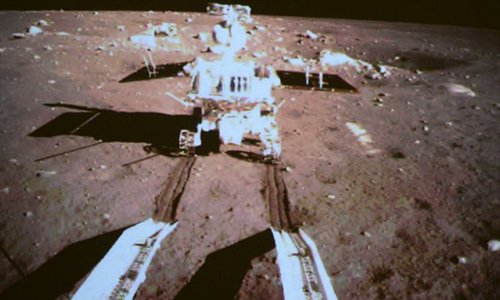
China's first lunar rover separates from Chang'e-3 moon lander early December 15, 2013. Picture was taken from the screen of the Beijing Aerospace Control Center in Beijing, capital of China. Photo: Xinhua
Why are human beings enthusiastic about exploring the Moon? The question has been raised again after China's Chang'e-4 probe successfully touched down in the far side of the Moon on January 3.
Zheng Yongchun, a research fellow from China's National Astronomical Observatories of the Chinese Academy of Sciences, said that the Moon is the nearest celestial body to the Earth and it has unique conditions to observe Mars, the Earth and other celestial bodies, Science and Technology Daily reported.
Zheng said that the Moon has no atmosphere and its far side has no artificial radio noise. Making astronomic observations from the far side of the Moon could capture weak signals from the dark universe and the stable geologic structure of the moon will benefit long-term observation.
The practice of using space-based resources for human missions in deep space instead of receiving regular cargo shipments from Earth of food, air, water rocket fuel and spare parts, is called in situ resource utilization.
"In situ resource utilization on the Moon will help humans build a station in deep space," Zheng said.
The target of humans is to land on Mars, which is at least 55 million kilometers away from Earth.
Although humanity has the technology to build a space station, the service life is short and the maintenance fees are high. The Moon would be an ideal transfer station and a good place to test the manned space technology.
"Assembling and launching spacecraft and using resources from the Moon as fuel would offer important support for exploration of deep space. Therefore, establishing a base on the Moon and launching spacecraft to Mars from the Moon is practical," said Zheng.
Pang Zhihao, a Beijing-based space communication expert, said that using the Moon as the transfer station for humanity to land on Mars would help save $10 billion every year.
The huge amount of energy resources on the Moon is another reason for humans to explore it. Pang said that the Moon has more than 1 million tons of helium-3, a clean and highly efficient fuel for thermal fusion power generation, which can be used to generate electricity for the Earth for as long as 10,000 years.
